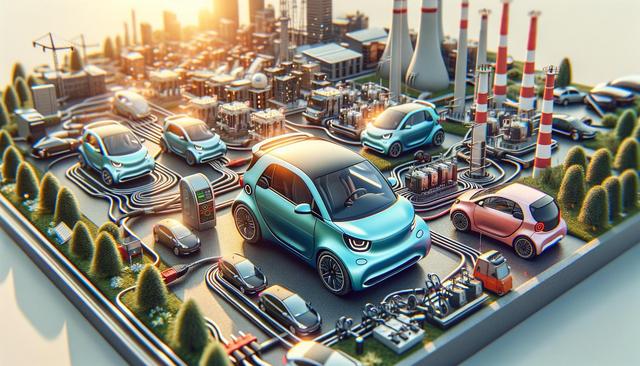
Embracing Efficiency: Your Guide to the New Wave of Electric Vehicles
Why Tiny Electric Cars Are Gaining Popularity
The rise of tiny electric cars reflects a broader movement toward efficiency and sustainability in urban transportation. As cities become more congested and environmental concerns grow, the demand for compact, eco-friendly vehicles has surged. These small electric vehicles are designed to meet the needs of city dwellers who prioritize easy parking, low maintenance, and minimal environmental impact. They are particularly appealing to younger drivers, retirees, and professionals who primarily travel short distances in urban settings. With their lower upfront costs compared to larger electric or gasoline-powered cars, tiny EVs offer a practical entry point into electric mobility.
Beyond affordability, the operational cost of tiny electric cars is also significantly lower. Owners benefit from reduced charging expenses, less frequent maintenance, and potential tax incentives or parking benefits in some cities. In many ways, these vehicles represent a thoughtful response to modern urban challenges—balancing mobility with sustainability.
Design and Practical Features
Despite their compact size, tiny electric cars are engineered with surprising practicality in mind. Their interiors are often optimized to comfortably seat one or two passengers, with smart storage solutions and intuitive controls that enhance the driving experience. While they may not offer expansive cargo space, they excel in maneuverability and convenience.
Key design features often include:
- Ultra-compact frame for easy navigation through tight city streets
- Regenerative braking systems to maximize energy efficiency
- Basic infotainment setups with smartphone connectivity
- Minimalist dashboards that reduce distractions and promote simplicity
Some models also come equipped with removable batteries, which can be charged at home or even in the office, adding another layer of flexibility for urban users. The straightforward nature of these vehicles is part of their appeal—they get drivers from point A to B efficiently, without unnecessary bells and whistles.
Environmental and Social Impact
One of the strongest arguments in favor of tiny electric cars is their reduced environmental footprint. Compared to traditional vehicles, these compact EVs require fewer resources to manufacture, emit no tailpipe emissions, and often consume less electricity overall. Many are even made using recyclable materials, further enhancing their sustainability profile.
From a societal perspective, tiny EVs contribute positively to urban planning initiatives. By taking up less space on the road and in parking areas, they help reduce city congestion and promote more walkable environments. Additionally, their low noise output contributes to quieter, more pleasant neighborhoods.
In cities where air quality is a growing concern, the adoption of electric vehicles—particularly smaller ones—can play a meaningful role in reducing pollution levels. Local governments often support this shift through incentives such as free or discounted parking, access to carpool lanes, or exemptions from congestion charges.
Who Should Consider a Tiny Electric Car?
Tiny electric vehicles are not a one-size-fits-all solution, but they are highly suitable for specific drivers and use cases. If you’re primarily commuting short distances, navigating dense urban routes, or looking for a secondary vehicle for quick errands, a tiny EV might be a fitting choice.
Ideal users include:
- City dwellers with limited parking availability
- Eco-conscious individuals seeking a low-impact lifestyle
- Commuters traveling short daily distances
- Retirees or students with simple driving needs
Because of their simplicity, tiny electric cars can also be a smart option for new drivers or those seeking a low-maintenance alternative to traditional cars. They are often easier to drive, park, and maintain—making them an attractive choice for a variety of demographics. However, for those with long commutes, large families, or extensive cargo needs, a different type of EV may be more appropriate.
Looking Ahead: The Future of Compact EVs
The market for tiny electric cars continues to evolve, with manufacturers investing in new technologies and design innovations to enhance performance and user experience. As battery technology improves, we can expect to see extended ranges, faster charging times, and even more compact designs that still offer impressive utility.
Looking forward, these vehicles are likely to play a larger role in shared mobility services, such as car-sharing platforms and urban delivery fleets. Their lower costs and environmental benefits make them ideal for fleet use in cities aiming to reduce emissions and improve traffic flow. Some cities are also experimenting with dedicated lanes and infrastructure tailored to smaller EVs, further supporting their adoption. Future developments may include:
- Integration with smart city infrastructure
- Advanced safety features like automated braking systems
- Connectivity with public transport systems to create seamless mobility solutions
- Wider adoption of solar charging stations for enhanced sustainability
As urban living continues to evolve, the role of tiny electric cars will likely grow, offering a flexible and sustainable mobility option for modern city life.
Conclusion: A Smarter Way to Navigate the City
Tiny electric cars present a compelling solution for individuals seeking efficient and environmentally responsible urban transportation. Their compact size, low operating costs, and minimal environmental impact make them a strong contender in the evolving landscape of personal mobility. For those living in cities or looking to reduce their carbon footprint, embracing this new wave of electric vehicles offers both practical and ecological benefits. As technology and infrastructure continue to improve, these compact EVs are poised to become a more integral part of modern urban life, promoting a cleaner, quieter, and more efficient way to move through the world.